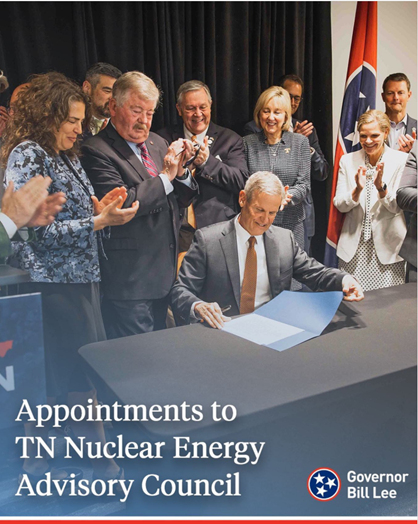After a robust build out of nuclear capacity towards the end of the 20th century, the United States is currently positioned to experience a nuclear renaissance.
(Download)
Executive Statement
While there are many models for advancing nuclear energy amongst the U.S. states and commonwealths, this report highlights the efforts of two Southeast states, Tennessee and Virginia, that have stood out for their unique advantages and incentives as they pursue further nuclear development. Virginia has created unique incentives for the nuclear industry and has attempted to leverage their robust university system in the commonwealth to produce graduates fluent in the technologies of the future, including nuclear technologies. Tennessee is creating a place-based ecosystem of expertise, similar to Silicon Valley, and is utilizing the robust ecosystem that has grown around the Oak Ridge federal facility. These models can inform other states and commonwealths eager to explore this burgeoning field.
Key Points
- Virginia has a robust history of nuclear energy that supersedes individual Governors and party lines.
- Tennessee has been core to the U.S. nuclear apparatus since the creation of the Manhattan Project.
- Virginia boasts a globally renowned tech industry and a commensurate power need.
- Tennessee’s population has recently grown at roughly twice the rate of the U.S.
- Tennessee has more than 229 nuclear companies operating in the state, and a university system that produces graduates for this field.
- Virginia has deployed novel policies to entice development, allowing utilities to begin recovering costs while they build improvements.
- Tennessee has one of the largest dedicated funds in the country devoted to spurring nuclear development.
After a robust build out of nuclear capacity towards the end of the 20th century, the United States is currently positioned to experience a nuclear renaissance for a litany of reasons, from increasing home and transportation electrification, to the rising tide of AI and associated data centers, to population growth. This boom offers the potential for billions of dollars of investment and thousands of new jobs as the nuclear industry attempts to be the industry of the future to help combat the ever-growing demand on the U.S. grid. As Governors consider how they can bring this industry and associated growth to their backyards, it is worth looking to states and commonwealths that have already begun their journey and understand how they got there.

Virginia
Virginia is a unique example of a commonwealth well positioned to embrace the future of nuclear energy, in large part because of a rare bipartisan consensus that has been the product of agency and university cooperation to promote the industry. This has been supplemented by the military resources stationed in the commonwealth that have provided a rich base of technical knowledge and professionals that have allowed Virginia to excel in nuclear development. Virginia also has a long history of nuclear power, being one of the first states/commonwealths to have nuclear power plants connected to the grid.
America’s nuclear energy experiment traces some of its roots to Virginia, which, in 1957 with the SM-1 Nuclear Reactor in Fort Belvoir, was one of the first atomic power generators to produce energy for the grid. This head start has cemented an acceptance of nuclear power in Virginia, a status that has allowed the nuclear industry in the commonwealth to maintain bipartisan consensus across administrations. This is particularly important in Virginia, where the Governor cannot serve consecutive terms, a relative rarity in gubernatorial politics. Virginia is also know for its political diversity, with the Governorship frequently changing political party. This makes the commonwealth’s progress on nuclear energy all the more compelling of a model as it demonstrates engagement across the aisle and throughout all strata of society in the commonwealth.
The commonwealth’s most recent nuclear renaissance began in 2013, with former Virginia Governor Bob McDonnell advocating for the creation of Virginia Nuclear Energy Consortium. This consortium was cemented into law in 2013 with H.B. 1790, officially creating the Virginia Nuclear Energy Consortium (VNEC), designed to make Virginia a global leader in nuclear energy generation. The consortium is composed of public and private higher education institutes in Virginia and business entities in the nuclear field. VNEC has been a consistent advocate for a nuclear future in Virginia, and its formal structure has given it staying power across administrations, notably that it was created under a Republican Governor and has continued under subsequent administrations of both parties. This makes it an enticing model for creating nuclear consensus, given the very long timelines required to advance nuclear power. One note of caution to potential emulators: another cause of the consortium’s success has been the established tradition of nuclear support in the commonwealth of Virginia, a product of the robust nuclear energy ecosystem in the commonwealth. This aspect of the consortium may be harder to replicate.
In 2019, the interest in nuclear continued in Virginia with H.B. 2008/S.B. 1348, which created the 17th Energy Career Cluster in the commonwealth’s education system, focused on the needs of the energy industry, including nuclear. This momentum continued with the passage of S.B. 828 and S.B. 549. The former included nuclear in Virginia’s definition of carbon free energy, and the latter directed state agencies to work with VNEC to incorporate nuclear energy into their carbon neutral planning. While the aforementioned focus on nuclear engagement and education is commendable, this alone would not be quite enough to put Virginia on the map in the manner it is. In recent years, Virginia Governor Glenn Youngkin has made significant strides to advance the state’s standing.

In Virginia’s 2022 State Energy Plan, Governor Youngkin set a goal for Virginia to host the nation’s first commercial SMR (Small Modular Reactor) within the next decade. Currently, the SMR industry is still in its infancy and faces cost barriers for siting, permitting, construction and deployment. In 2024, to address these challenges, Governor Youngkin played a key role in crafting and supporting legislation that allows utilities to petition for SMRs. The legislation also allows SMR developers in Virginia to seek regulatory approval for cost recovery on “evaluation, design, engineering, federal approval and licensing, environmental analysis and permitting, early site permitting, equipment procurement, and an authorized rate of return” on SMR projects. Subject to regulatory approval, this allows developers to recover development-related costs for SMRs, reducing barriers of entry into the emerging energy sector. Traditional cost recovery occurs over the life cycle of the facility and typically begins upon completion of a project. This new model, known as the Virginia Nuclear Innovation Hub, utilizes an innovative approach to funding and financing energy generation projects. A key objective of this project has been to foster a whole of Virginia approach to nuclear investments, with a focus on siting these projects in the southern part of the state.
Another prong to Virginia’s success in innovating and promoting nuclear power has been the dynamic northern part of the state, home to an ecosystem of technology companies. The tech sector in this region is anchored by the data center industry, which chose the region for its relatively cheap power, at one-point cheap land and proximity to sizeable populations of college educated individuals. As this industry grows and increasingly grapples with the cost of energy as well as beliefs about the need for clean energy, it has begun to invest in novel solutions to its energy needs. Following the signing of the 2022 State Energy Plan by Governor Youngkin, Dominion Energy Virginia and Appalachian Power Company (APCo) have announced plans to develop SMRs in Virginia. Dominion has announced a partnership with Amazon to utilize SMRs to power data centers located in Virginia. While this is a flagship project, Virginia has also maintained a consistent drum beat of project support, such as support for an expanded nuclear servicing facility in Lynchburg. It is this investment into the nuclear ecosystem that allows Virginia to attract flagship projects and partners and seems to make Virginia a well-rounded option for companies looking to invest in the future of nuclear.
In addition to encouraging the development of new power generation, this approach seeks to grow Virginia’s energy sector and create jobs. The Governor’s office worked with the legislature as legislation developed to ensure that ratepayers will be protected under this new process. For example, APCo would be limited to a total of $125 million in overall cost recovery, and cost recovery for Dominion Energy Virginia would not be able to exceed a $1.40 individual increase of ratepayer monthly bills, subject to regulatory approval.

Tennessee
The history of nuclear power and weapons is inextricably linked to Tennessee, as it was the host to some of the first breakthrough facilities in the research and development of the U.S. Nuclear Program. Starting in 1942, Oak Ridge, Tennessee, was selected to host the first plutonium and uranium enrichment sites for the Manhattan Project. After the success of this mission, Oak Ridge began research into radioisotopes for industry, agriculture, and medicine. Tennessee has maintained its nuclear industry in the intervening years, and the unique Oak Ridge site continues to provide a testing ground for both public and private innovations. One reason Oak Ridge is uniquely situated to take advantage of the nuclear renaissance is the history of nuclear-related activity on site. While remediation efforts are underway, leveraging this historically unique land for productive use offers a lower risk of contaminating additional land for further research.
Tennessee has sought to maintain this nuclear energy advantage, especially under current Tennessee Governor Bill Lee, who has touted the state’s expertise to attract investment and resources. He has highlighted that Tennessee derives more power from nuclear energy than from any other source. Governor Lee has also spearheaded other efforts, such as funding nuclear education at Tennessee’s universities, classifying nuclear as clean energy, and to helping solicit next-generation investments like the Orano USA uranium enrichment plant, which will be located within the footprint of the Oak Ridge Site. The Governor established a Nuclear Energy Advisory Council, created by Executive Order 101, which aims to continue Tennessee’s storied nuclear tradition by positioning the state as an excellent site for future innovations in the field. This effort followed a partnership between the Tennessee General Assembly to create a $50M nuclear fund to expand the nuclear development and manufacturing ecosystem for the future of Tennessee. (This fund was increased by $10 million in Fiscal Year 2025 and another $10 million in Fiscal Year 2026.) This plan is notable as this fund is ten times larger than Virginia’s similar fund.

These efforts capitalize on Tennessee’s already healthy ecosystem, which is comprised of more than 229 nuclear companies, of which 154 are in the Oak Ridge-Knoxville area. These actions are critical not only for the economic competitiveness of the region, but also to keep the lights on. Tennessee Valley Authority (TVA) projects the region’s population to grow at three times the national average, and the GDP of TVA’s service territory grew 0.5% faster than the national average in 2023.
Tennessee is unusual in that the TVA, a federally owned utility corporation, provides electricity for 99.7% of the electric service territory in Tennessee. TVA is an incredibly complex entity, run by a board appointed by the President and confirmed by the Senate, and it is notable as one of the largest operators of nuclear power stations in the country. Its role as a utility entails close cooperation with the Governor and his staff. Governor Lee has a strong working relationship with TVA, saying, “Tennesseans appreciate TVA’s continued investment in safe, clean and reliable nuclear energy for the future. This additional investment, coupled with the state’s focus on creating a nuclear energy ecosystem, will ensure Tennessee is the number one state for nuclear energy companies to invest and thrive, driving continued opportunity and economic growth.” Statements such as this underscore Tennessee’s ability to maintain its lead in the field of nuclear energy. The Governor has gone even further recently, establishing another $50 million fund to support TVA’s Clinch River Small Modular Reactor project. However, the flip side of this particular situation is that other states might not see as many opportunities to emulate this model.
These models differ, as a large part of Virginia’s efforts involve working to stand up the educational ecosystem to produce graduates eager to partake in this field–something Tennessee has done for quite some time due to the partnership of the University of Tennessee and the Oak Ridge National Lab. However, Virginia has extant data center demand, and the large tech companies that underwrite this activity are more apt to invest billions of private dollars to shore up the grid. This isn’t to say Tennessee is a laggard, as its complex network of nuclear companies creates something of a Silicon Valley of nuclear, where talented workers can quickly change jobs to more innovative firms without uprooting their families’ lives. The corporate makeup of Tennessee and Virginia differs on the lines of expertise and capital. Tennessee is also much more beholden to the priorities of the federal government, with TVA’s and the Oak Ridge complex’s connections to the federal government, unlike the private utilities of Virginia. In summation, Virginia is more empowered to stake its own course as it develops nuclear generation, whereas Tennessee has the dual-edged sword of federal priorities.












